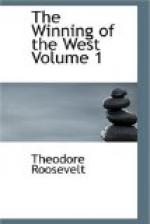Three other similar forts or stations were built about the same time as Boonsborough, namely: Harrodstown, Boiling Springs, and St. Asaphs, better known as Logan’s Station, from its founder’s name. These all lay to the southwest, some thirty odd miles from Boonsborough. Every such fort or station served as the rallying-place for the country round about, the stronghold in which the people dwelt during time of danger; and later on, when all danger had long ceased, it often remained in changed form, growing into the chief town of the district. Each settler had his own farm besides, often a long way from the fort, and it was on this that he usually intended to make his permanent home. This system enabled the inhabitants to combine for defence, and yet to take up the large tracts of four to fourteen hundred acres,[16] to which they were by law entitled. It permitted them in time of peace to live well apart, with plenty of room between, so that they did not crowd one another—a fact much appreciated by men in whose hearts the spirit of extreme independence and self-reliance was deeply ingrained. Thus the settlers were scattered over large areas, and, as elsewhere in the southwest, the county and not the town became the governmental unit. The citizens even of the smaller governmental divisions acted through representatives, instead of directly, as in the New England town-meetings.[17] The centre of county government was of course the county court-house.
Henderson, having established a land agency at Boonsborough, at once proceeded to deed to the Transylvania colonists entry certificates of surveys of many hundred thousand acres. Most of the colonists were rather doubtful whether these certificates would ultimately prove of any value, and preferred to rest their claims on their original cabin rights; a wise move on their part, though in the end the Virginia Legislature confirmed Henderson’s sales in so far as they had been made to actual settlers. All the surveying was of course of the very rudest kind. Only a skilled woodsman could undertake the work in such a country; and accordingly much of it devolved on Boon, who ran the lines as well as he could, and marked the trees with his own initials, either by powder or else with his knife.[18] The State could not undertake to make the surveys itself, so it authorized the individual settler to do so. This greatly promoted the rapid settlement of the country, making it possible to deal with land as a commodity, and outlining the various claims; but the subsequent and inevitable result was that the sons of the settlers reaped a crop of endless confusion and litigation.




